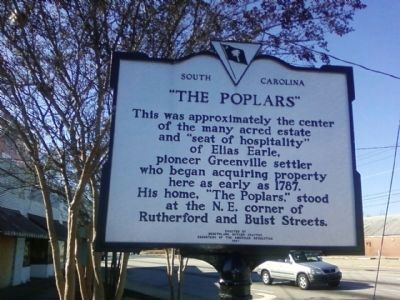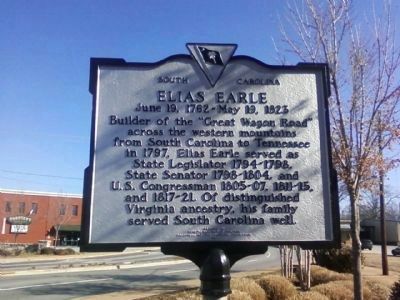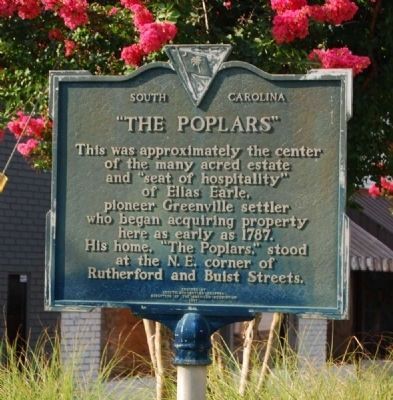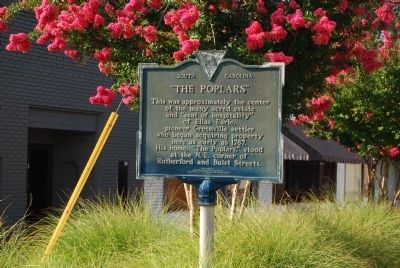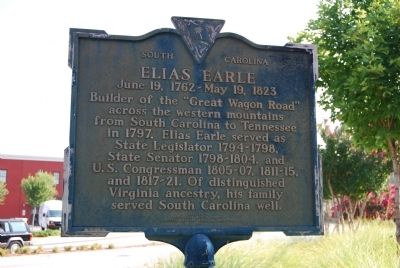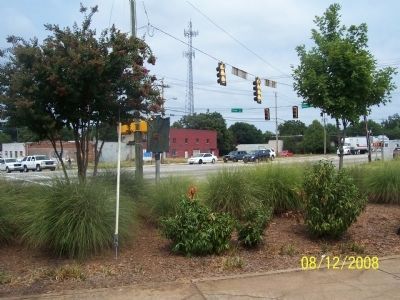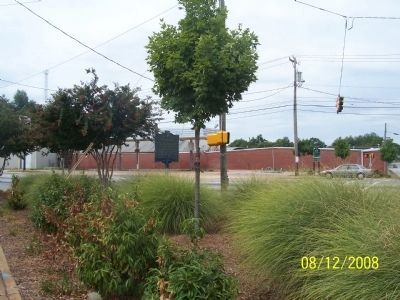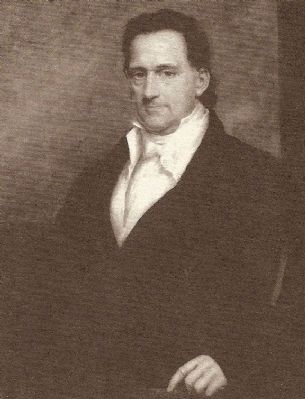Greenville in Greenville County, South Carolina — The American South (South Atlantic)
"The Poplars" / Elias Earle
Elias Earle
June 19, 1762-May 19, 1823
Erected 1967 by Behethland Chapter, Daughters of the American Revolution. (Marker Number 23-9.)
Topics and series. This historical marker is listed in these topic lists: Colonial Era • Roads & Vehicles • Settlements & Settlers. In addition, it is included in the Daughters of the American Revolution series list. A significant historical month for this entry is June 1847.
Location. 34° 52.051′ N, 82° 24.255′ W. Marker is in Greenville, South Carolina, in Greenville County. Marker is at the intersection of Rutherford Street (State Highway 25) and Poinsett Highway and Shaw Street, on the right when traveling north on Rutherford Street. Touch for map. Marker is in this post office area: Greenville SC 29609, United States of America. Touch for directions.
Other nearby markers. At least 10 other markers are within walking distance of this marker. Whitehall (approx. 0.3 miles away); Brutontown (approx. 0.4 miles away); Poe Mill (approx. half a mile away); Lawrence Peter Hollis (approx. 0.6 miles away); General Nathanael Greene (approx. ¾ mile away); Soldier's Rest (approx. 0.8 miles away); Old Greenville Graveyard (approx. 0.8 miles away); Greenville Woman's College (approx. 0.8 miles away); McPherson Park (approx. 0.9 miles away); Post 3 American Legion (approx. 0.9 miles away). Touch for a list and map of all markers in Greenville.
Also see . . .
1. Elias Earle. Elias Earle (June 19, 1762 - May 19, 1823) was a United States Representative from South Carolina. (Submitted on March 20, 2009, by Brian Scott of Anderson, South Carolina.)
2. Col. Elias Earle Historic District. The Colonel Elias Earle Historic District is significant for its mixture of early twentieth century architecture. (Submitted on August 9, 2008, by Brian Scott of Anderson, South Carolina.)
3. Great Wagon Road. The Great Wagon Road was a colonial American thoroughfare from Pennsylvania to North Carolina and from there to Georgia. (Submitted on September 20, 2009, by Brian Scott of Anderson, South Carolina.)
Additional commentary.
1. Earle, Elias, (1762 - 1823)
Earle, Elias, (uncle of Samuel Earle and John Baylis Earle and great-grandfather of John Laurens Manning Irby and Joseph Haynsworth Earle), a Representative from South Carolina; born in Frederick County, Va., June 19, 1762; attended private school; moved to Greenville County, S.C., in September 1787; was one of the earliest ironmasters of the South, and prospected and negotiated in the iron region of Georgia; member of South Carolina house of representatives, 1794-1797; member of the State senate in 1800; elected as a Republican to the Ninth Congress (March 4, 1805-March 3, 1807); elected to the Twelfth and Thirteenth Congresses (March 4, 1811-March 3, 1815); again elected to the Fifteenth and Sixteenth Congresses (March 4, 1817-March 3, 1821); died in Centerville, S.C., May 19, 1823; interment in Old Earle Cemetery, Buncombe Road, Greenville, S.C. (Source: Biographical Directory of the U.S. Congress.)
— Submitted March 20, 2009, by Brian Scott of Anderson, South Carolina.
2. Elias Earle
Like many early settlers, the ancestors of Elias Earle left England for Virginia in the 1600s and then migrated south down the Great Wagon Road through the Shenandoah Valley to settle in the Carolinas. When Earle himself moved to Greenville in September 1787, he set to work, historical documents show, acquiring land, eventually amassing several thousand acres and thirty-three slaves.
Perhaps Earle's first public involvement surfaced during the debate over whether or not to relocate the Greenville courthouse to land he owned near the Reedy River. When the courthouse site was selected, it went instead to land owned by his rival, notable Greenvillian Lemuel J. Alston.
Undeterred by the loss, Early continued to plat an active role in government dealings, being elected both to the state house of representatives and the state senate. It was during his tenure in the senate that Earle was appointed to a committee considering the possibility of a wagon road to be built over the mountains of western North Carolina.
Under Earle's leadership, the South Carolina legislature appropriated funds to construct a road "wide enough for four horses to pull a wagon with a load weighing one tone [sic]." Officials overseeing construction of the road actually contracted with Earle and one of his relatives, John William Gowen, to build it, and by November 1797 the road was completed. As modern U.S. 25, this thoroughfare continues to serve as a primary connector between the Upstate and western North Carolina. (Source: G: The Magazine of Greenville, Jan/Feb 09, pgs 64-65.)
— Submitted March 20, 2009, by Brian Scott of Anderson, South Carolina.
3. Elias Earle: History in Brief
At a Glance: As one of the original landowners in the village of Greenville, Earle served as a colonel in the South Carolina militia and would eventually be elected to the state house of representatives, the state senate, and the United States Congress. In 1802 he founded the state's first ironworks and the north fork of the Saluda River.
Claim to Fame: Earle was instrumental in securing funding for the construction of the first wagon road that would connect Greenville and the Upstate with trading markets in North Carolina and Tennessee.
Did You Know?: Earle and his wife, Francis Robinson, are buried in the Earle Family Cemetery, located on Old Bumcombe Road in the Sans Souci neighborhood.
Dirty Politics: During his 1806 re-election campaign for U.S. Congress, Earle once recruited supporters by setting up a bench in the middle of the street to freely dispense whiskey to all comers. Although he didn't win that bid for office, Earle later reclaimed his congressional seat. (Source: G: The Magazine of Greenville, Jan/Feb 09, pg 65.)
— Submitted March 20, 2009, by Brian Scott of Anderson, South Carolina.
Credits. This page was last revised on December 13, 2019. It was originally submitted on July 12, 2008, by Brian Scott of Anderson, South Carolina. This page has been viewed 2,497 times since then and 54 times this year. Photos: 1, 2. submitted on March 14, 2011, by Stanley and Terrie Howard of Greer, South Carolina. 3. submitted on October 19, 2010, by Brian Scott of Anderson, South Carolina. 4, 5. submitted on July 12, 2008, by Brian Scott of Anderson, South Carolina. 6, 7. submitted on August 13, 2008, by M. L. 'Mitch' Gambrell of Taylors, South Carolina. 8. submitted on September 20, 2009, by Brian Scott of Anderson, South Carolina. • Kevin W. was the editor who published this page.
